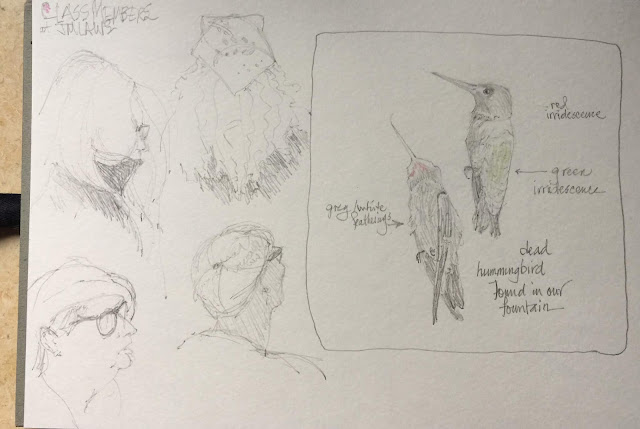Where do birds go when it is raining?
We live near open grasslands and wooded areas, so we see lots of different wildlife around us. They frequent our backyard starting in the spring. In winter, the deer go elsewhere. Sometimes I see them on the hills at the end of the street getting the last bit of grass or peeking out beneath the low-hanging branches of oaks that grow next to the creek.

In the summer they hop our low fence and follow their own path up our hill to the top where they nap, chew their cuds and later come down the hill and out our driveway.
I'm still going to John Muir Laws' demos about drawing living, moving animals and birds.
I've discovered that like all art skills, I need to practice for a long time to learn to capture animals in motion. Try it. Sit outside and try to capture a bird moving around you. You will find that you will barely get a stick figure down or the top of a head and maybe the back of the tail before the animal or bird moves. It is hard!
It is much easier for me to look for photos to practice the animal's anatomy. I can learn the differences between a finch and a phoebe and add those markings to my drawing quickly. Looking at dead specimens helps me to understand the parts of animals too. (Even the sad specimen of a hummingbird here.)
In class I find myself turning to my usual practice of drawing living, moving humans. As we all sit attentively watching John's presentation, I draw the heads of the participants. I know how to draw humans, so if they move, I can fill in the blanks. But the people in the class are so often mesmerized during the lecture, that they don't move, and I can capture them as they sit. Maybe I should give them names just like the birds and other animals. What would you call them?






It's so fun to see your process coming through in these sketches, Martha. And in your classroom specimens, I see a Wispy Contemplative and a Captivated Hat bill.
ReplyDeleteThank you, Teresa. I like to look at sketches for the same reason. I like your names you've suggested too. Have a good holiday and write on!
Delete